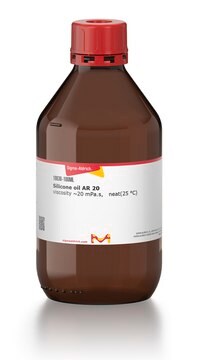85409
Silicone oil
for oil baths (from −50°C to +200°C)
Sinónimos:
Dimethyl polysiloxane
Iniciar sesiónpara Ver la Fijación de precios por contrato y de la organización
About This Item
Fórmula lineal:
[-Si(CH3)2O-]n
Número de CAS:
MDL number:
UNSPSC Code:
12352100
NACRES:
NA.21
Productos recomendados
grade
for oil baths (from −50°C to +200°C)
Quality Level
vapor density
>1 (vs air)
vapor pressure
<5 mmHg ( 25 °C)
5 mmHg ( 20 °C)
form
oil
refractive index
n20/D 1.403 (lit.)
n20/D 1.406
viscosity
100 mPa.s(20 °C)
bp
>140 °C/0.002 mmHg (lit.)
density
0.967 g/mL at 20 °C
¿Está buscando productos similares? Visita Guía de comparación de productos
General description
Silicone oil is typically used for oil baths in research labs for reactions that require heating/reflux temperatures in the range of -50°C to +200°C. Oil baths provide more uniform heat in comparison to other heating devices.
Silicone oil is useful for the preparation of oil baths having a temperature in the range of -50°C to +200°C.
Application
Silicone oil has been used for the protection of carbon steel alloy samples in a study. Silicone oil has also been used as a heat reservoir during NMR (Nuclear Magnetic Resonance) analysis.
Storage Class
10 - Combustible liquids
wgk_germany
WGK 1
flash_point_f
214.0 °F - closed cup
flash_point_c
101.1 °C - closed cup
ppe
Eyeshields, Gloves
Elija entre una de las versiones más recientes:
¿Ya tiene este producto?
Encuentre la documentación para los productos que ha comprado recientemente en la Biblioteca de documentos.
Los clientes también vieron
Low-temperature atomic layer deposition of Al2O3 thin coatings for corrosion protection of steel: surface and electrochemical analysis.
Diaz B, et al.
Corrosion Science, 53(6), 2168-2175 (2011)
M Findeisen et al.
Magnetic resonance in chemistry : MRC, 45(2), 175-178 (2006-12-13)
Most established NMR thermometers rely on temperature-dependent chemical shift differences measured from samples that are either neat or concentrated solutions (e.g. ethylene glycol, methanol). These are unsuitable for modern cryoprobes on account of strong radiation damping resulting from the high
Tindaro Ioppolo et al.
Journal of visualized experiments : JoVE, (71)(71), e50199-e50199 (2013-02-15)
Optical modes of dielectric micro-cavities have received significant attention in recent years for their potential in a broad range of applications. The optical modes are frequently referred to as "whispering gallery modes" (WGM) or "morphology dependent resonances" (MDR) and exhibit
Benjamin R Schudel et al.
Lab on a chip, 13(5), 811-817 (2013-01-31)
RNA interference (RNAi) is a powerful tool for functional genomics with the capacity to comprehensively analyze host-pathogen interactions. High-throughput RNAi screening is used to systematically perturb cellular pathways and discover therapeutic targets, but the method can be tedious and requires
M Brun et al.
Conference proceedings : ... Annual International Conference of the IEEE Engineering in Medicine and Biology Society. IEEE Engineering in Medicine and Biology Society. Annual Conference, 2012, 6281-6284 (2013-02-01)
This paper demonstrates the potential use of a new microfluidic device embedding thick electrodes for cell lysis and cell separation applications. The system consists of a microfluidic channel featuring conductive walls made of a polydimethylsiloxane (PDMS) matrix mixed with carbon
Nuestro equipo de científicos tiene experiencia en todas las áreas de investigación: Ciencias de la vida, Ciencia de los materiales, Síntesis química, Cromatografía, Analítica y muchas otras.
Póngase en contacto con el Servicio técnico



